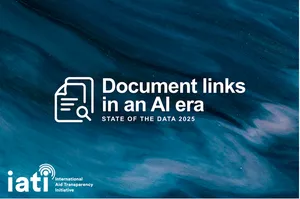Explore IATI State of the Data Analysis: How can half a million documents enhance aid transparency?

Documents linked through the IATI Standard are a gold mine of qualitative information about international development and humanitarian activities.
From project details, contracts, budgets, evaluations and more, documents provide rich, contextual insights on what’s being funded, how it’s being delivered, and what results are achieved.
Now, artificial intelligence is changing how we search, analyse and act on information in the development and humanitarian sectors – from funding and policy to frontline delivery. In this shifting context, documents linked through the IATI Standard have taken on a new importance.
Explore IATI State of the Data Analysis: Document Links in an AI Era
IATI State of the Data: Document Links in an AI Era examines nearly half a million documents linked to by over 900 organisations. It provides a snapshot of current publishing practices, and suggests practical ways to strengthen IATI data for the future.
- Explore the interactive analysis
- Join the conversation on IATI Connect
- Contribute your ideas in our upcoming webinars
This is the first of a new series of analyses focused on how the IATI Standard is being used in practice, and what can be improved to support better decisions, greater transparency and stronger accountability.

Three key takeaways and questions:
- Which organisations publish?
At the time of the analysis, almost 500,000 unique document links have been published by over 900 organisations. Over 90% of linked documents belong to governments and multinational organisations.
Just five reporting organisations publish over half of all document links.
How well does this reflect the whole IATI publisher Community? Who could be missing from the picture?
Budgets are the most popular category of documents published– at the time of the analysis, 150,681 document links contain budget information.
- What types of information are in linked documents?
It’s possible to declare one or more categories for each document. The top five categories are – in order – budgets, results, objectives, activity webpages, and conditions. 97% of document links declare at least one category, with 52% of them including multiple categories.
Budgets are the most popular category of documents published– at the time of the analysis, 150,681 document links contain budget information.
Who benefits from what’s in these documents What might be missing?
- What formats are linked documents published in?
Most documents are published as PDFs or webpages. 57.9% of documents are PDFs. The second most popular format is HTML, with 29.5% of documents published as webpages.
We used to treat PDFs as hard to reuse. Has that changed with the advent of Large Learning Models? How much additional information might be available on webpages?
Join our Community Dialogue to explore this analysis further
What comes next?
The IATI Secretariat is sharing these findings as a starting point and inviting the IATI community to help shape what comes after. Whether you are a publisher, policymaker or data user, your input can help turn these insights into practical next steps.
Join Data Dialogue: Document links in an AI Era
- Webinar 1 Tuesday 8 July - Join our Community Dialogue to explore this analysis further. We’ll share key findings, answer questions, and open up a conversation on what comes next for document links.
- Webinar 2 Tuesday 15 July - Learn more on how the data is used through AI. Hear about innovative work from the UK Foreign, Commonwealth & Development Office and Germany’s Federal Ministry for Economic Cooperation and Development (BMZ).